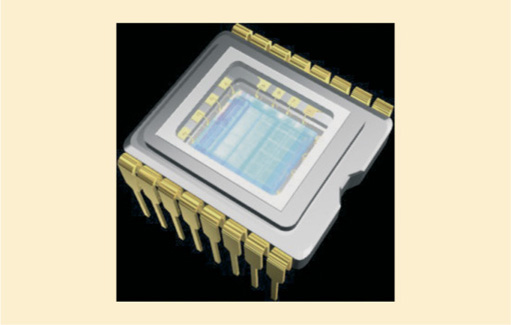4.2.4 CCD light sensor
The CCD light sensor is a transducer that converts light to an electrical signal. CCD stands for 'charge coupled device', and physically a CCD light sensor is an integrated circuit with a transparent cover. A photograph of one is shown in Figure 6. Under the cover is a rectangular array of light-sensitive electronic components called photosites. You do not need to know the mechanism involved, but each photosite provides an analogue electrical output that measures how bright the light is on that site. Each photosite can therefore contribute one pixel to the detected image. Important parameters of a CCD light sensor are the size of the light-sensitive area and the number of photosites – and hence the number of pixels in the image it can produce.

The size of the device is usually expressed in terms of the length of a diagonal line from one corner of the rectangle to the other. As you often find in IT, advances in the technology lead to a reduction in the size, with the same or better performance and maybe lower cost. CCD sensors are an example of this as Taylor observes in his 2004 updating paper:
[There has been] the widespread adoption of small hand held mini-camcorders producing good quality images from small 1/3rd inch CCDs originally developed for the consumer market. An enormous amount of Japanese development effort has gone into producing high resolution, high sensitivity small CCDs to the point where current 1/3rd inch CCD produces better all round performance than a standard 2/3rd inch broadcast format camcorder of 5 years ago, but at around only 20% of the cost. Now there is a trend to move to 1/5th inch CCDs which will enable even cheaper and more compact camcorders. This lower cost has enabled news companies to put greater numbers of camcorders into the field and gather wider cross section of material.
For high-resolution images large numbers of pixels are needed, and at the time of writing, camcorders can have up to several 'megapixels', where one megapixel is 1 million pixels (106 pixels).
Activity 11
If a camcorder has a CCD with an array of 811 pixels horizonally by 508 pixels vertically, how many pixels is that in total? Give your answer to two significant figures using scientific notation.
Discussion
811 pixels horizontally by 508 pixels vertically gives a total of 811×508=411,988 pixels. To two significant figures that is 410,000, or 4.1×105, using scientific notation.
The output from one photosite on a CCD is a measure of how bright the light is at that site. It contains no information about the colour of the light. To get colour information, coloured filters are placed in front of the CCD so that separate photosites measure the brightness in each of the three primary colours of light: red, blue and green.
Some cameras use separate CCDs for each of the three colours whereas others use a single CCD with different coloured filters interleaved over individual sites, but the details of the configuration of the filters does not concern us here. If you want to know more you will be able to find information by searching on the Web.
Instead of using CCDs for light sensors, some cameras use CMOS (complementary metal oxide semiconductor) sensors. There are differences between CCD sensors and CMOS sensors – broadly speaking CCD sensors provide better image quality but cameras using CMOS sensors can be smaller – but at the level of the discussion here they essentially perform the same function.
I shall now return to the lens system of the camera, to explain how it focuses the light.
